Evaluation of Undergraduates' Critical Thinking Outcomes Essay
VerifiedAdded on 2023/01/10
|7
|1926
|45
Essay
AI Summary
This essay critically examines a research paper titled "Assessment of Undergraduates’ Real-World Outcomes of Critical Thinking in Everyday Situations." The paper defines critical thinking as a combination of cognitive skills impacting success in various aspects of life and explores the relationship between behavior and critical thinking. The essay discusses the research methods used, including surveys and mixed research design, to assess the psychometric qualities of the real-world outcome (RWO) inventory and its ability to identify everyday behaviors of students and employees. The essay agrees with the paper's findings on the RWO inventory's effectiveness in evaluating critical thinking and highlights the significance of the HCTA test. It also critiques the paper's discussion on the social dimension of college and identifies strengths such as in-depth analysis and weaknesses such as limited information on the RWO inventory. The essay concludes that the RWO inventory can determine the nature of individuals in everyday situations and provides a platform for detecting critical thinking.
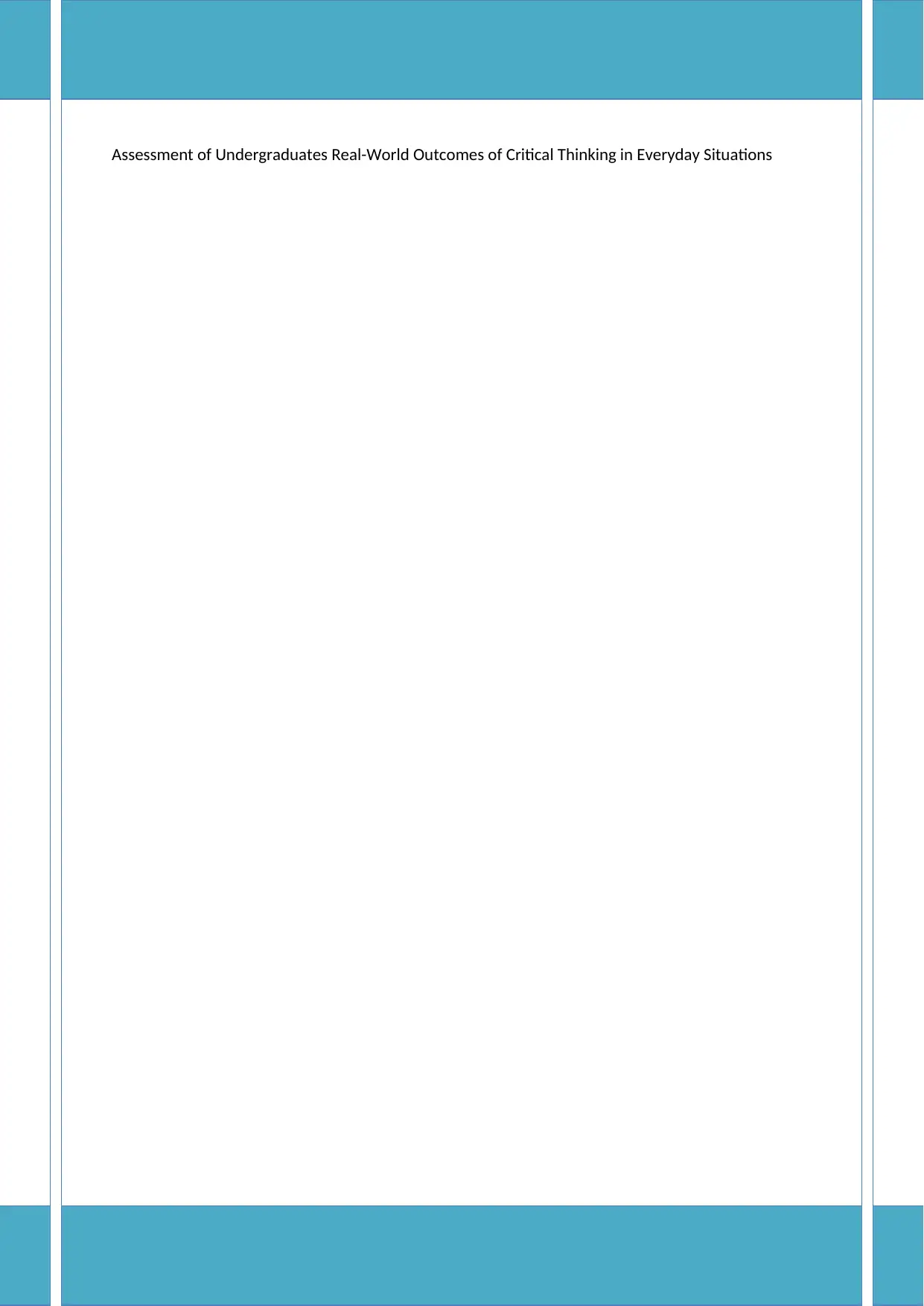
Assessment of Undergraduates Real-World Outcomes of Critical Thinking in Everyday Situations
Paraphrase This Document
Need a fresh take? Get an instant paraphrase of this document with our AI Paraphraser
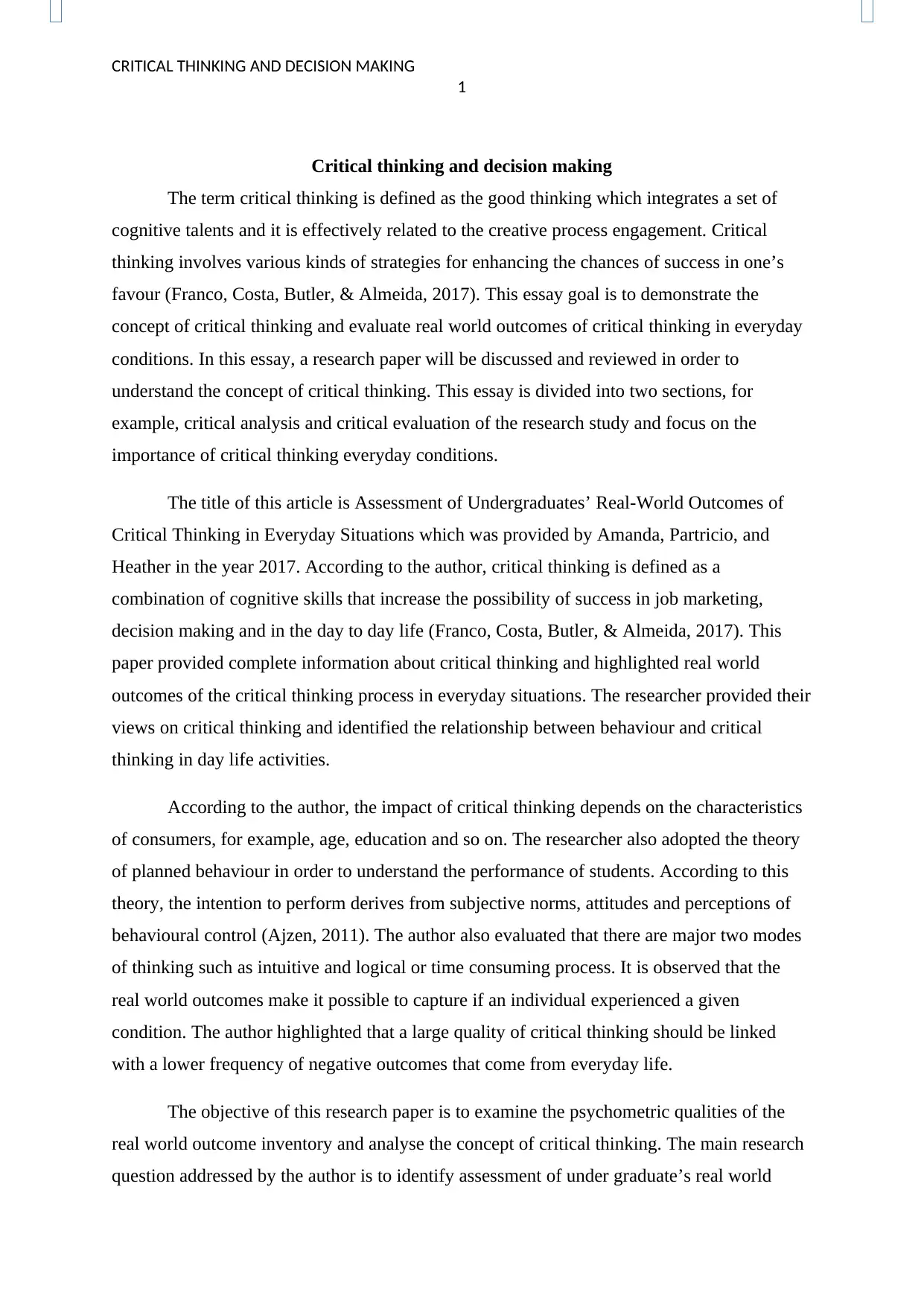
CRITICAL THINKING AND DECISION MAKING
1
Critical thinking and decision making
The term critical thinking is defined as the good thinking which integrates a set of
cognitive talents and it is effectively related to the creative process engagement. Critical
thinking involves various kinds of strategies for enhancing the chances of success in one’s
favour (Franco, Costa, Butler, & Almeida, 2017). This essay goal is to demonstrate the
concept of critical thinking and evaluate real world outcomes of critical thinking in everyday
conditions. In this essay, a research paper will be discussed and reviewed in order to
understand the concept of critical thinking. This essay is divided into two sections, for
example, critical analysis and critical evaluation of the research study and focus on the
importance of critical thinking everyday conditions.
The title of this article is Assessment of Undergraduates’ Real-World Outcomes of
Critical Thinking in Everyday Situations which was provided by Amanda, Partricio, and
Heather in the year 2017. According to the author, critical thinking is defined as a
combination of cognitive skills that increase the possibility of success in job marketing,
decision making and in the day to day life (Franco, Costa, Butler, & Almeida, 2017). This
paper provided complete information about critical thinking and highlighted real world
outcomes of the critical thinking process in everyday situations. The researcher provided their
views on critical thinking and identified the relationship between behaviour and critical
thinking in day life activities.
According to the author, the impact of critical thinking depends on the characteristics
of consumers, for example, age, education and so on. The researcher also adopted the theory
of planned behaviour in order to understand the performance of students. According to this
theory, the intention to perform derives from subjective norms, attitudes and perceptions of
behavioural control (Ajzen, 2011). The author also evaluated that there are major two modes
of thinking such as intuitive and logical or time consuming process. It is observed that the
real world outcomes make it possible to capture if an individual experienced a given
condition. The author highlighted that a large quality of critical thinking should be linked
with a lower frequency of negative outcomes that come from everyday life.
The objective of this research paper is to examine the psychometric qualities of the
real world outcome inventory and analyse the concept of critical thinking. The main research
question addressed by the author is to identify assessment of under graduate’s real world
1
Critical thinking and decision making
The term critical thinking is defined as the good thinking which integrates a set of
cognitive talents and it is effectively related to the creative process engagement. Critical
thinking involves various kinds of strategies for enhancing the chances of success in one’s
favour (Franco, Costa, Butler, & Almeida, 2017). This essay goal is to demonstrate the
concept of critical thinking and evaluate real world outcomes of critical thinking in everyday
conditions. In this essay, a research paper will be discussed and reviewed in order to
understand the concept of critical thinking. This essay is divided into two sections, for
example, critical analysis and critical evaluation of the research study and focus on the
importance of critical thinking everyday conditions.
The title of this article is Assessment of Undergraduates’ Real-World Outcomes of
Critical Thinking in Everyday Situations which was provided by Amanda, Partricio, and
Heather in the year 2017. According to the author, critical thinking is defined as a
combination of cognitive skills that increase the possibility of success in job marketing,
decision making and in the day to day life (Franco, Costa, Butler, & Almeida, 2017). This
paper provided complete information about critical thinking and highlighted real world
outcomes of the critical thinking process in everyday situations. The researcher provided their
views on critical thinking and identified the relationship between behaviour and critical
thinking in day life activities.
According to the author, the impact of critical thinking depends on the characteristics
of consumers, for example, age, education and so on. The researcher also adopted the theory
of planned behaviour in order to understand the performance of students. According to this
theory, the intention to perform derives from subjective norms, attitudes and perceptions of
behavioural control (Ajzen, 2011). The author also evaluated that there are major two modes
of thinking such as intuitive and logical or time consuming process. It is observed that the
real world outcomes make it possible to capture if an individual experienced a given
condition. The author highlighted that a large quality of critical thinking should be linked
with a lower frequency of negative outcomes that come from everyday life.
The objective of this research paper is to examine the psychometric qualities of the
real world outcome inventory and analyse the concept of critical thinking. The main research
question addressed by the author is to identify assessment of under graduate’s real world
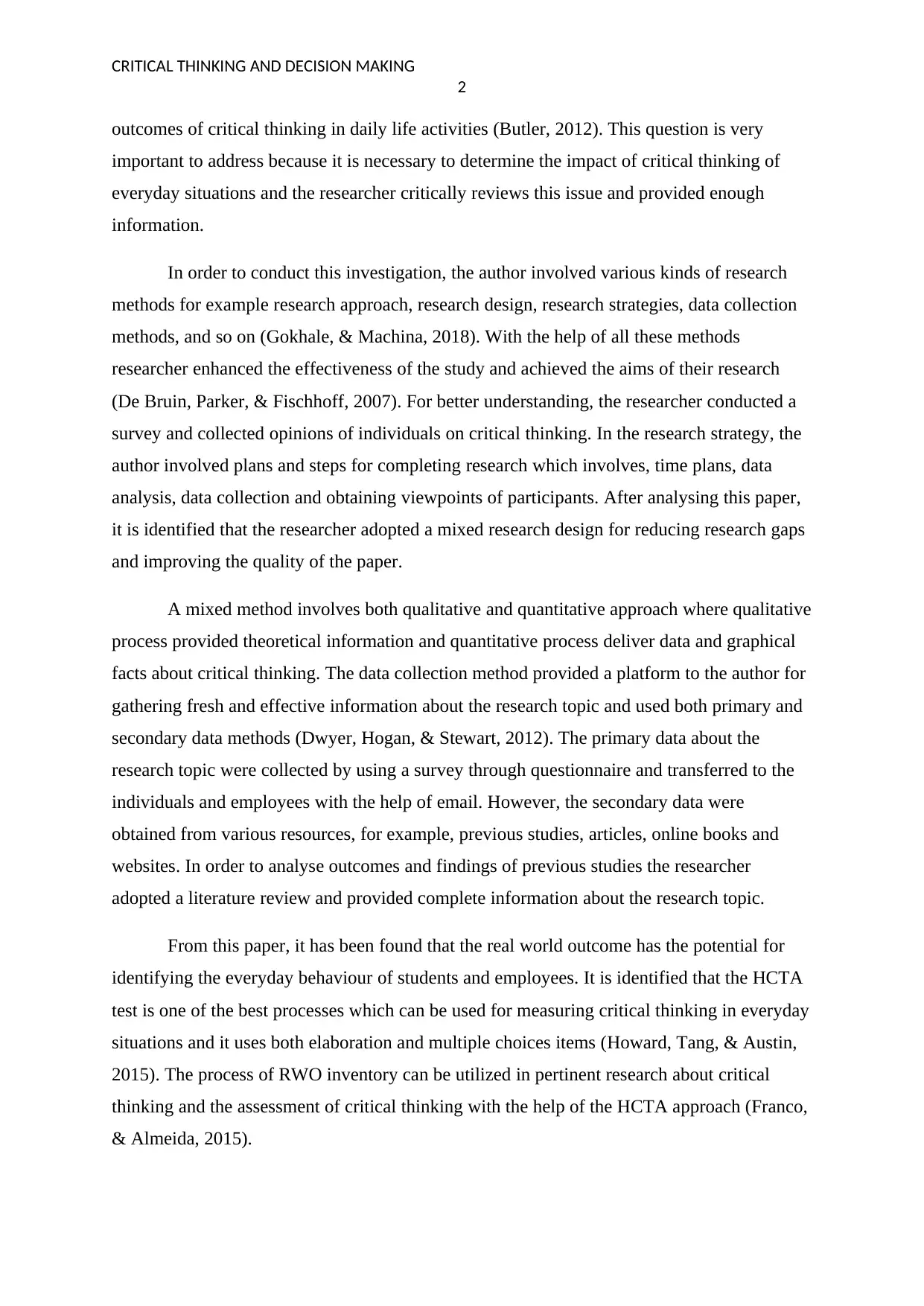
CRITICAL THINKING AND DECISION MAKING
2
outcomes of critical thinking in daily life activities (Butler, 2012). This question is very
important to address because it is necessary to determine the impact of critical thinking of
everyday situations and the researcher critically reviews this issue and provided enough
information.
In order to conduct this investigation, the author involved various kinds of research
methods for example research approach, research design, research strategies, data collection
methods, and so on (Gokhale, & Machina, 2018). With the help of all these methods
researcher enhanced the effectiveness of the study and achieved the aims of their research
(De Bruin, Parker, & Fischhoff, 2007). For better understanding, the researcher conducted a
survey and collected opinions of individuals on critical thinking. In the research strategy, the
author involved plans and steps for completing research which involves, time plans, data
analysis, data collection and obtaining viewpoints of participants. After analysing this paper,
it is identified that the researcher adopted a mixed research design for reducing research gaps
and improving the quality of the paper.
A mixed method involves both qualitative and quantitative approach where qualitative
process provided theoretical information and quantitative process deliver data and graphical
facts about critical thinking. The data collection method provided a platform to the author for
gathering fresh and effective information about the research topic and used both primary and
secondary data methods (Dwyer, Hogan, & Stewart, 2012). The primary data about the
research topic were collected by using a survey through questionnaire and transferred to the
individuals and employees with the help of email. However, the secondary data were
obtained from various resources, for example, previous studies, articles, online books and
websites. In order to analyse outcomes and findings of previous studies the researcher
adopted a literature review and provided complete information about the research topic.
From this paper, it has been found that the real world outcome has the potential for
identifying the everyday behaviour of students and employees. It is identified that the HCTA
test is one of the best processes which can be used for measuring critical thinking in everyday
situations and it uses both elaboration and multiple choices items (Howard, Tang, & Austin,
2015). The process of RWO inventory can be utilized in pertinent research about critical
thinking and the assessment of critical thinking with the help of the HCTA approach (Franco,
& Almeida, 2015).
2
outcomes of critical thinking in daily life activities (Butler, 2012). This question is very
important to address because it is necessary to determine the impact of critical thinking of
everyday situations and the researcher critically reviews this issue and provided enough
information.
In order to conduct this investigation, the author involved various kinds of research
methods for example research approach, research design, research strategies, data collection
methods, and so on (Gokhale, & Machina, 2018). With the help of all these methods
researcher enhanced the effectiveness of the study and achieved the aims of their research
(De Bruin, Parker, & Fischhoff, 2007). For better understanding, the researcher conducted a
survey and collected opinions of individuals on critical thinking. In the research strategy, the
author involved plans and steps for completing research which involves, time plans, data
analysis, data collection and obtaining viewpoints of participants. After analysing this paper,
it is identified that the researcher adopted a mixed research design for reducing research gaps
and improving the quality of the paper.
A mixed method involves both qualitative and quantitative approach where qualitative
process provided theoretical information and quantitative process deliver data and graphical
facts about critical thinking. The data collection method provided a platform to the author for
gathering fresh and effective information about the research topic and used both primary and
secondary data methods (Dwyer, Hogan, & Stewart, 2012). The primary data about the
research topic were collected by using a survey through questionnaire and transferred to the
individuals and employees with the help of email. However, the secondary data were
obtained from various resources, for example, previous studies, articles, online books and
websites. In order to analyse outcomes and findings of previous studies the researcher
adopted a literature review and provided complete information about the research topic.
From this paper, it has been found that the real world outcome has the potential for
identifying the everyday behaviour of students and employees. It is identified that the HCTA
test is one of the best processes which can be used for measuring critical thinking in everyday
situations and it uses both elaboration and multiple choices items (Howard, Tang, & Austin,
2015). The process of RWO inventory can be utilized in pertinent research about critical
thinking and the assessment of critical thinking with the help of the HCTA approach (Franco,
& Almeida, 2015).
⊘ This is a preview!⊘
Do you want full access?
Subscribe today to unlock all pages.

Trusted by 1+ million students worldwide
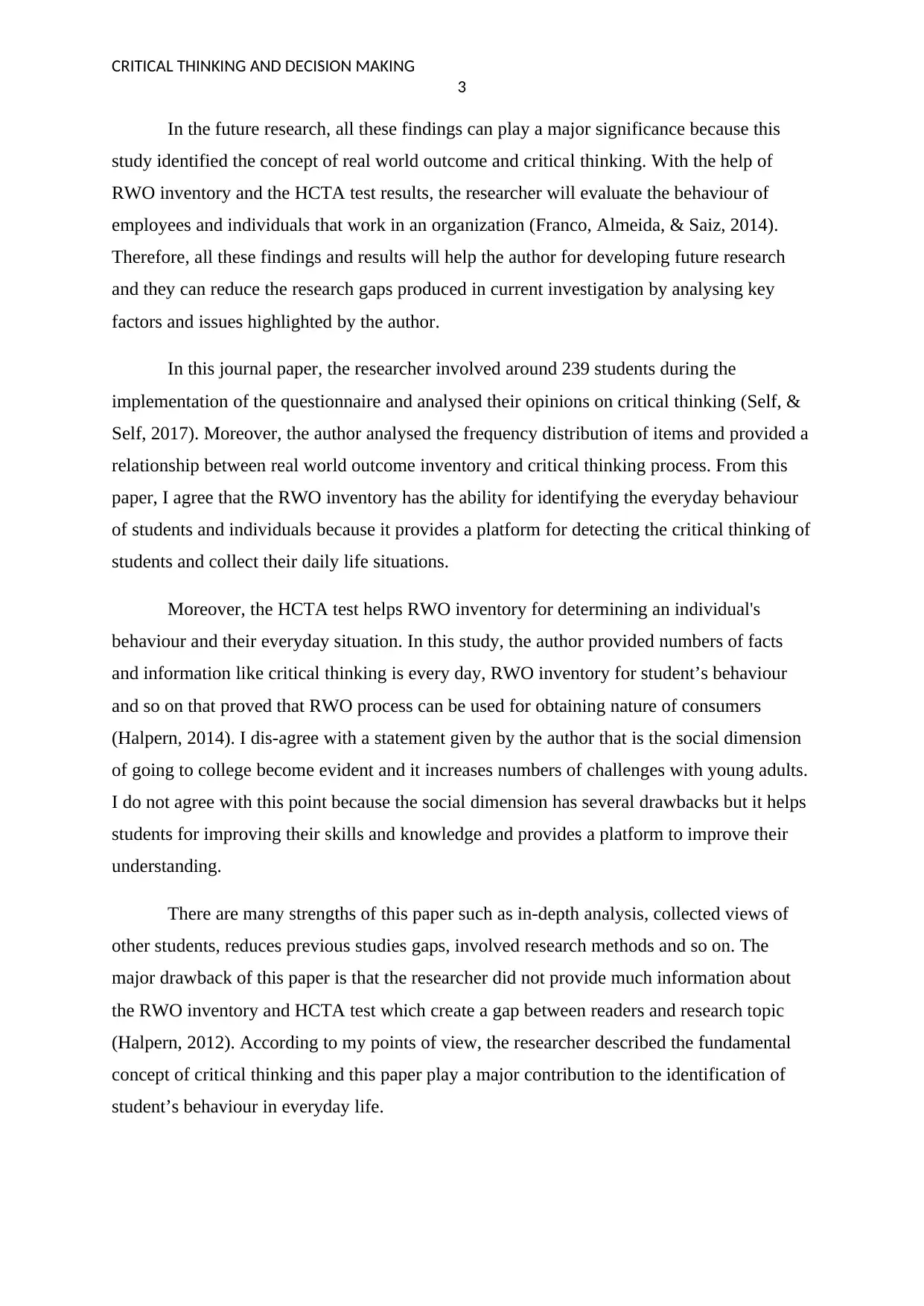
CRITICAL THINKING AND DECISION MAKING
3
In the future research, all these findings can play a major significance because this
study identified the concept of real world outcome and critical thinking. With the help of
RWO inventory and the HCTA test results, the researcher will evaluate the behaviour of
employees and individuals that work in an organization (Franco, Almeida, & Saiz, 2014).
Therefore, all these findings and results will help the author for developing future research
and they can reduce the research gaps produced in current investigation by analysing key
factors and issues highlighted by the author.
In this journal paper, the researcher involved around 239 students during the
implementation of the questionnaire and analysed their opinions on critical thinking (Self, &
Self, 2017). Moreover, the author analysed the frequency distribution of items and provided a
relationship between real world outcome inventory and critical thinking process. From this
paper, I agree that the RWO inventory has the ability for identifying the everyday behaviour
of students and individuals because it provides a platform for detecting the critical thinking of
students and collect their daily life situations.
Moreover, the HCTA test helps RWO inventory for determining an individual's
behaviour and their everyday situation. In this study, the author provided numbers of facts
and information like critical thinking is every day, RWO inventory for student’s behaviour
and so on that proved that RWO process can be used for obtaining nature of consumers
(Halpern, 2014). I dis-agree with a statement given by the author that is the social dimension
of going to college become evident and it increases numbers of challenges with young adults.
I do not agree with this point because the social dimension has several drawbacks but it helps
students for improving their skills and knowledge and provides a platform to improve their
understanding.
There are many strengths of this paper such as in-depth analysis, collected views of
other students, reduces previous studies gaps, involved research methods and so on. The
major drawback of this paper is that the researcher did not provide much information about
the RWO inventory and HCTA test which create a gap between readers and research topic
(Halpern, 2012). According to my points of view, the researcher described the fundamental
concept of critical thinking and this paper play a major contribution to the identification of
student’s behaviour in everyday life.
3
In the future research, all these findings can play a major significance because this
study identified the concept of real world outcome and critical thinking. With the help of
RWO inventory and the HCTA test results, the researcher will evaluate the behaviour of
employees and individuals that work in an organization (Franco, Almeida, & Saiz, 2014).
Therefore, all these findings and results will help the author for developing future research
and they can reduce the research gaps produced in current investigation by analysing key
factors and issues highlighted by the author.
In this journal paper, the researcher involved around 239 students during the
implementation of the questionnaire and analysed their opinions on critical thinking (Self, &
Self, 2017). Moreover, the author analysed the frequency distribution of items and provided a
relationship between real world outcome inventory and critical thinking process. From this
paper, I agree that the RWO inventory has the ability for identifying the everyday behaviour
of students and individuals because it provides a platform for detecting the critical thinking of
students and collect their daily life situations.
Moreover, the HCTA test helps RWO inventory for determining an individual's
behaviour and their everyday situation. In this study, the author provided numbers of facts
and information like critical thinking is every day, RWO inventory for student’s behaviour
and so on that proved that RWO process can be used for obtaining nature of consumers
(Halpern, 2014). I dis-agree with a statement given by the author that is the social dimension
of going to college become evident and it increases numbers of challenges with young adults.
I do not agree with this point because the social dimension has several drawbacks but it helps
students for improving their skills and knowledge and provides a platform to improve their
understanding.
There are many strengths of this paper such as in-depth analysis, collected views of
other students, reduces previous studies gaps, involved research methods and so on. The
major drawback of this paper is that the researcher did not provide much information about
the RWO inventory and HCTA test which create a gap between readers and research topic
(Halpern, 2012). According to my points of view, the researcher described the fundamental
concept of critical thinking and this paper play a major contribution to the identification of
student’s behaviour in everyday life.
Paraphrase This Document
Need a fresh take? Get an instant paraphrase of this document with our AI Paraphraser
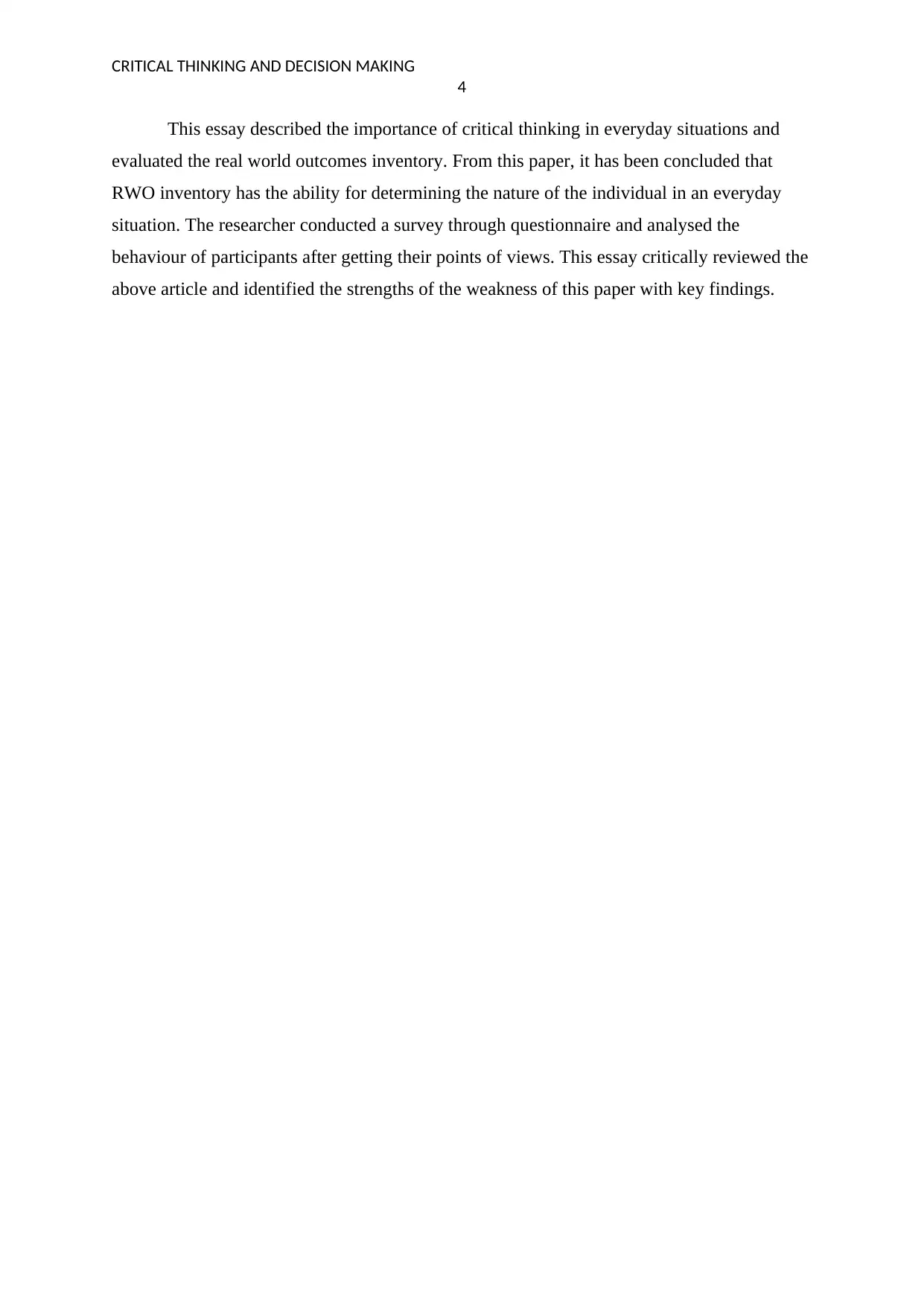
CRITICAL THINKING AND DECISION MAKING
4
This essay described the importance of critical thinking in everyday situations and
evaluated the real world outcomes inventory. From this paper, it has been concluded that
RWO inventory has the ability for determining the nature of the individual in an everyday
situation. The researcher conducted a survey through questionnaire and analysed the
behaviour of participants after getting their points of views. This essay critically reviewed the
above article and identified the strengths of the weakness of this paper with key findings.
4
This essay described the importance of critical thinking in everyday situations and
evaluated the real world outcomes inventory. From this paper, it has been concluded that
RWO inventory has the ability for determining the nature of the individual in an everyday
situation. The researcher conducted a survey through questionnaire and analysed the
behaviour of participants after getting their points of views. This essay critically reviewed the
above article and identified the strengths of the weakness of this paper with key findings.
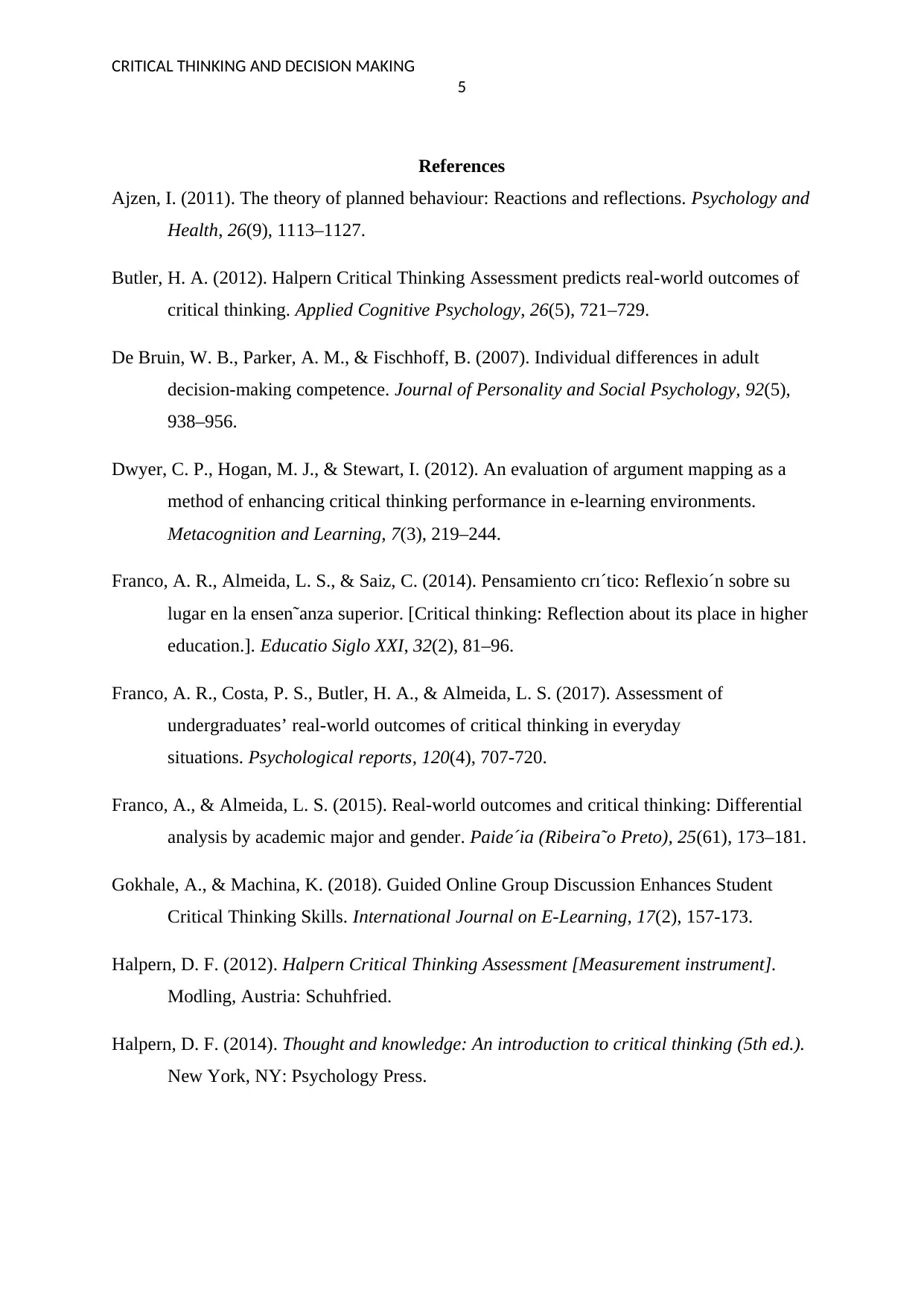
CRITICAL THINKING AND DECISION MAKING
5
References
Ajzen, I. (2011). The theory of planned behaviour: Reactions and reflections. Psychology and
Health, 26(9), 1113–1127.
Butler, H. A. (2012). Halpern Critical Thinking Assessment predicts real-world outcomes of
critical thinking. Applied Cognitive Psychology, 26(5), 721–729.
De Bruin, W. B., Parker, A. M., & Fischhoff, B. (2007). Individual differences in adult
decision-making competence. Journal of Personality and Social Psychology, 92(5),
938–956.
Dwyer, C. P., Hogan, M. J., & Stewart, I. (2012). An evaluation of argument mapping as a
method of enhancing critical thinking performance in e-learning environments.
Metacognition and Learning, 7(3), 219–244.
Franco, A. R., Almeida, L. S., & Saiz, C. (2014). Pensamiento crı´tico: Reflexio´n sobre su
lugar en la ensen˜anza superior. [Critical thinking: Reflection about its place in higher
education.]. Educatio Siglo XXI, 32(2), 81–96.
Franco, A. R., Costa, P. S., Butler, H. A., & Almeida, L. S. (2017). Assessment of
undergraduates’ real-world outcomes of critical thinking in everyday
situations. Psychological reports, 120(4), 707-720.
Franco, A., & Almeida, L. S. (2015). Real-world outcomes and critical thinking: Differential
analysis by academic major and gender. Paide´ia (Ribeira˜o Preto), 25(61), 173–181.
Gokhale, A., & Machina, K. (2018). Guided Online Group Discussion Enhances Student
Critical Thinking Skills. International Journal on E-Learning, 17(2), 157-173.
Halpern, D. F. (2012). Halpern Critical Thinking Assessment [Measurement instrument].
Modling, Austria: Schuhfried.
Halpern, D. F. (2014). Thought and knowledge: An introduction to critical thinking (5th ed.).
New York, NY: Psychology Press.
5
References
Ajzen, I. (2011). The theory of planned behaviour: Reactions and reflections. Psychology and
Health, 26(9), 1113–1127.
Butler, H. A. (2012). Halpern Critical Thinking Assessment predicts real-world outcomes of
critical thinking. Applied Cognitive Psychology, 26(5), 721–729.
De Bruin, W. B., Parker, A. M., & Fischhoff, B. (2007). Individual differences in adult
decision-making competence. Journal of Personality and Social Psychology, 92(5),
938–956.
Dwyer, C. P., Hogan, M. J., & Stewart, I. (2012). An evaluation of argument mapping as a
method of enhancing critical thinking performance in e-learning environments.
Metacognition and Learning, 7(3), 219–244.
Franco, A. R., Almeida, L. S., & Saiz, C. (2014). Pensamiento crı´tico: Reflexio´n sobre su
lugar en la ensen˜anza superior. [Critical thinking: Reflection about its place in higher
education.]. Educatio Siglo XXI, 32(2), 81–96.
Franco, A. R., Costa, P. S., Butler, H. A., & Almeida, L. S. (2017). Assessment of
undergraduates’ real-world outcomes of critical thinking in everyday
situations. Psychological reports, 120(4), 707-720.
Franco, A., & Almeida, L. S. (2015). Real-world outcomes and critical thinking: Differential
analysis by academic major and gender. Paide´ia (Ribeira˜o Preto), 25(61), 173–181.
Gokhale, A., & Machina, K. (2018). Guided Online Group Discussion Enhances Student
Critical Thinking Skills. International Journal on E-Learning, 17(2), 157-173.
Halpern, D. F. (2012). Halpern Critical Thinking Assessment [Measurement instrument].
Modling, Austria: Schuhfried.
Halpern, D. F. (2014). Thought and knowledge: An introduction to critical thinking (5th ed.).
New York, NY: Psychology Press.
⊘ This is a preview!⊘
Do you want full access?
Subscribe today to unlock all pages.

Trusted by 1+ million students worldwide
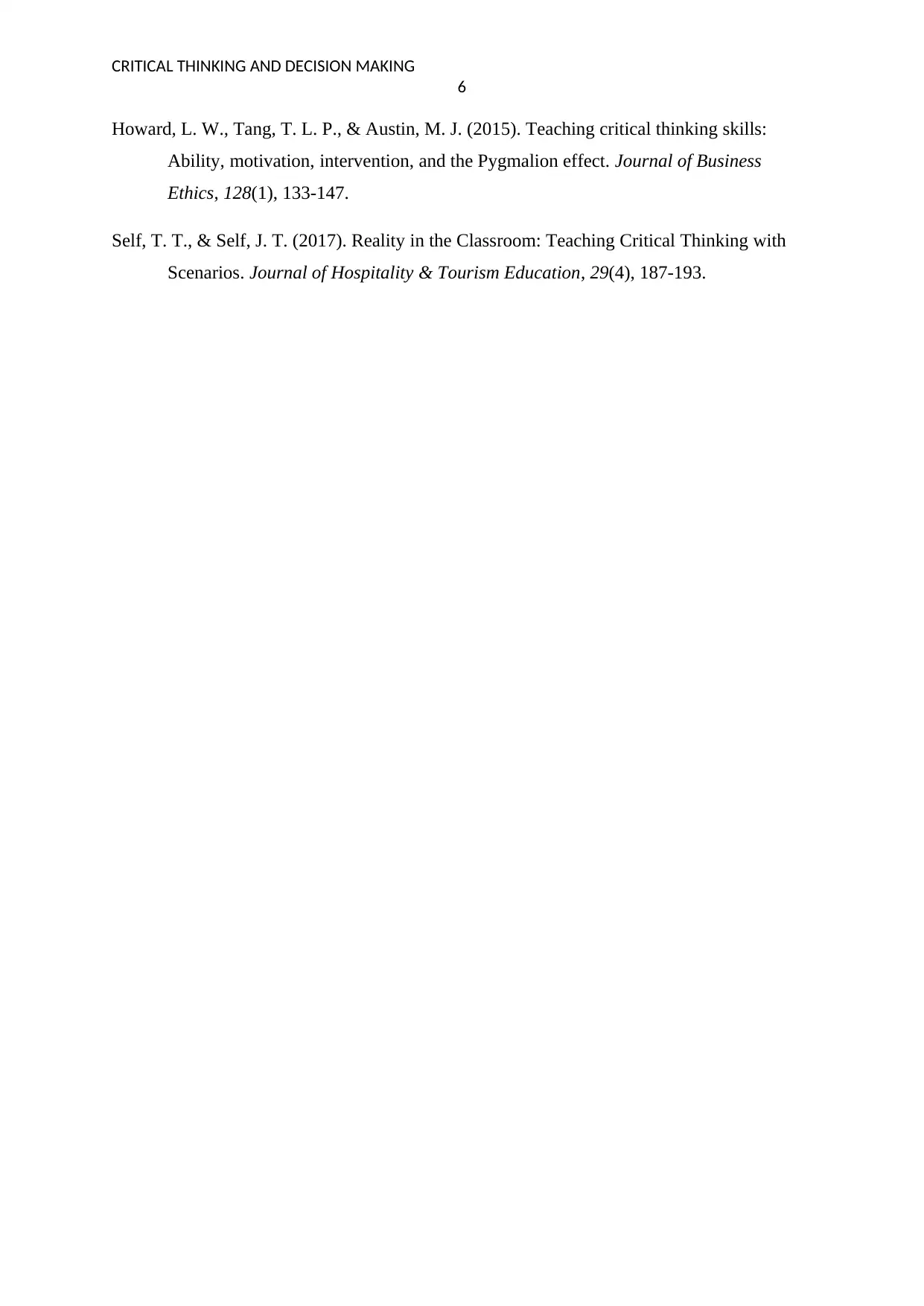
CRITICAL THINKING AND DECISION MAKING
6
Howard, L. W., Tang, T. L. P., & Austin, M. J. (2015). Teaching critical thinking skills:
Ability, motivation, intervention, and the Pygmalion effect. Journal of Business
Ethics, 128(1), 133-147.
Self, T. T., & Self, J. T. (2017). Reality in the Classroom: Teaching Critical Thinking with
Scenarios. Journal of Hospitality & Tourism Education, 29(4), 187-193.
6
Howard, L. W., Tang, T. L. P., & Austin, M. J. (2015). Teaching critical thinking skills:
Ability, motivation, intervention, and the Pygmalion effect. Journal of Business
Ethics, 128(1), 133-147.
Self, T. T., & Self, J. T. (2017). Reality in the Classroom: Teaching Critical Thinking with
Scenarios. Journal of Hospitality & Tourism Education, 29(4), 187-193.
1 out of 7
Related Documents
Your All-in-One AI-Powered Toolkit for Academic Success.
+13062052269
info@desklib.com
Available 24*7 on WhatsApp / Email
![[object Object]](/_next/static/media/star-bottom.7253800d.svg)
Unlock your academic potential
Copyright © 2020–2025 A2Z Services. All Rights Reserved. Developed and managed by ZUCOL.





